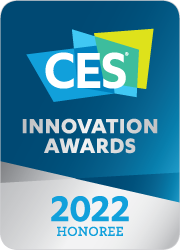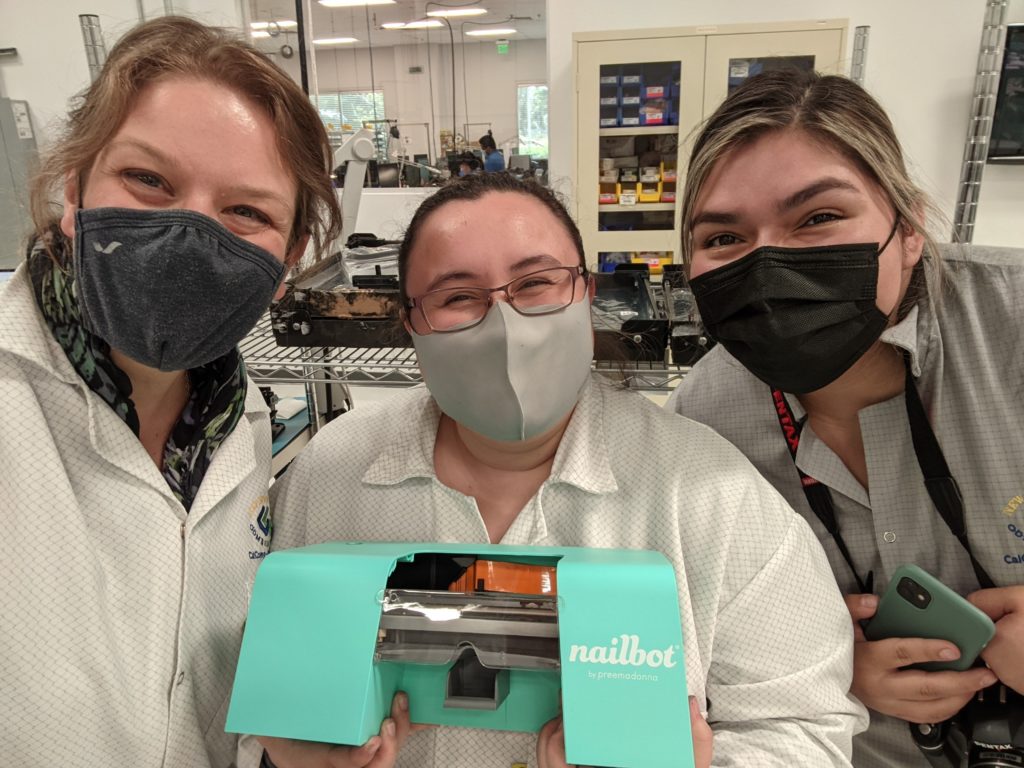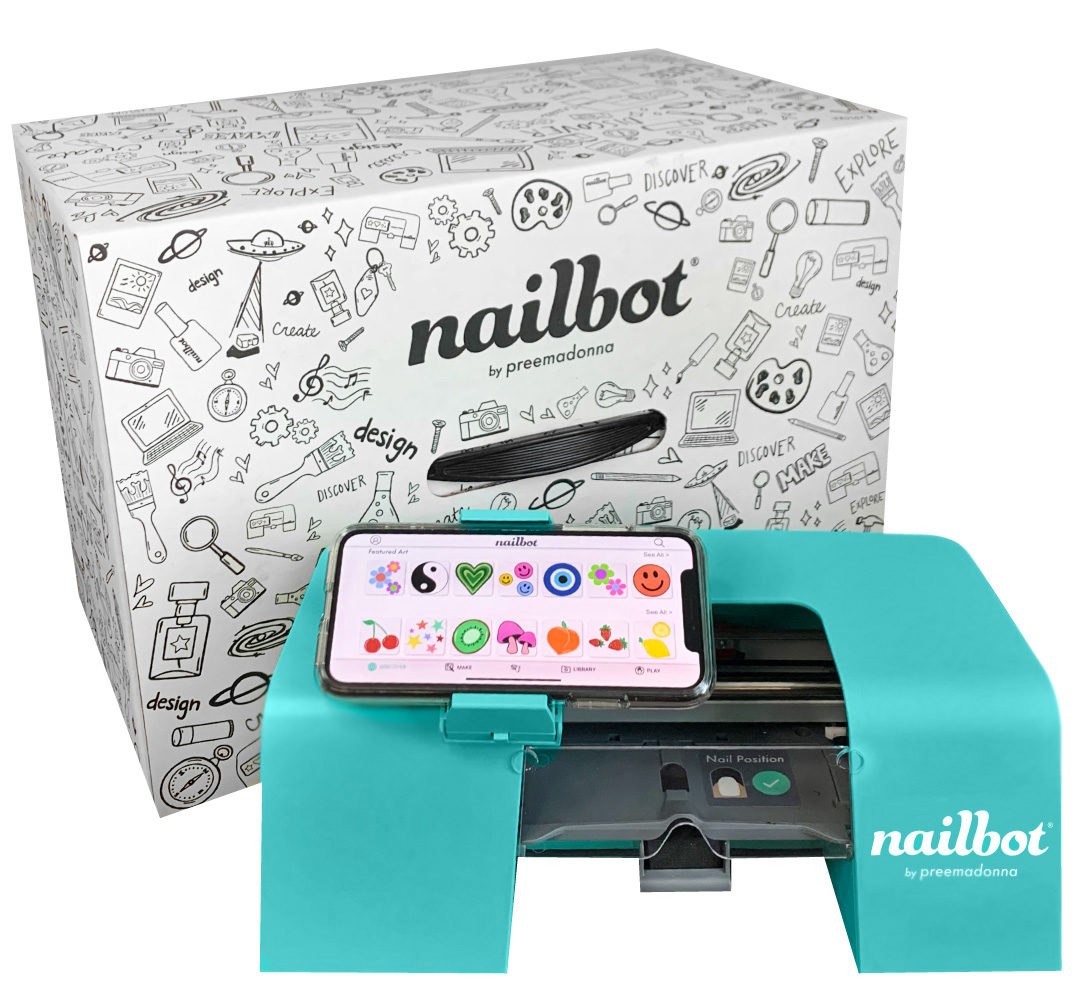CASE STUDY: NAILBOT BY PREEMADONNA
A Connected, At-home Fingernail Decorating Device
![]()
THE CHALLENGE
Preemadonna came to Simplexity with a novel product idea called the Nailbot, a connected, at-home fingernail decorating device that could print full-color art and photos on fingernails in seconds. Founder Pree Walia led her team to create an MVP working Nailbot by modifying an off the shelf inkjet printer to prove the concept. They garnered significant industry recognition by becoming TechCrunch Disrupt Startup Battlefield finalists. Preemadonna’s earliest working prototypes printed over Wi-Fi, did not have a working service station and were large in size.
Preemadonna and Simplexity partnered to bring Nailbot to an advanced design from an early working conceptual prototype. Below is the final product hitting the market.
 Preemadonna vision
Preemadonna vision
THE DEVELOPMENT
Phase 1: Requirements and Planning
The goal of Phase 1 was to evaluate the state of the preliminary design, define the product requirements, and develop a project plan that addressed Preemadonna’s development priorities and critical project risks for the Nailbot. For example, Preemadonna required that all user interface functionality be accomplished via a smartphone. Furthermore, communication between the Nailbot and the smartphone was to be wireless. Additional requirements pertained to the printed image size and resolution, the delay time between initiating a print on the smartphone and having the print on the fingernail, as well as the target bill of materials cost.
Phase 2A: Architecture
Simplexity has unparalleled experience developing printing products in a variety of form factors, with decades of experience designing inkjet printers. With Preemadonna having established a licensing agreement with an inkjet printing conglomerate, Simplexity set out to architect a compact, low-cost version of an inkjet printer.
The Carriage
One important area considered was the carriage, the part of the printer that moves the ink cartridges to the desired printing location. In the Nailbot, the carriage would hold a single cyan/magenta/yellow (CMY) cartridge rather than dual CMY and black cartridges found in most inkjet printers.
The Service Station
Another important area considered was the service station. Modern thermal inkjet printers have sophisticated service stations that keep the printhead nozzles working optimally, thus maintaining the best print quality over time. Functions include spitting, capping, and wiping which are defined below.
Spitting: The printer spits ink to help clear clogged nozzles. Spitting occurs at regular intervals, as well as before and after printing. Part of the service station is a spittoon, a pit to contain the volume of discharged ink.
Capping: Capping the printhead nozzles when not in use prevents them from drying out. The capping action is activated by a sled mechanism that is automatically engaged when the carriage travels out of the print zone.
Wiping: Wiping removes dust, dried ink, and foreign particles from the printhead nozzles. Thermal inkjet inks are designed to dry quickly and permanently, so wet ink must not be allowed to dry on the nozzles. To prevent color smearing, wiping must take place in an axis perpendicular to carriage travel. Usually this is done by a separate carriage motor, but the objective in the Nailbot was to use only one motor. Simplexity proposed a novel design that would automatically engage the wiperactuated by carriage motion.
Electrical Considerations
On the electrical side, Simplexity again looked to simplify the inkjet printer. Working with Preemadonna, we agreed that the most suitable wireless protocol was Bluetooth low energy (BLE), due to the close proximity between smartphone and Nailbot, as well as the low data transmission rate. Simplexity was able to streamline the electrical components into one main PCA board and took consideration of the positioning of the BLE antenna to maximize the connection with the smartphone.
Power Supply
Another important consideration was the power supply. Although Preemadonna had entertained a battery-powered option, Simplexity engineers and the Preemadonna team calculated a power budget verifying that battery power was not feasible if the Nailbot was going to be light, portable, and long-lasting. It was agreed that the Nailbot would be plugged into an outlet.
Firmware Considerations
There were also important firmware architecture considerations. The MCU for the Nailbot had to carry out numerous low-level tasks, such as implementing a hierarchical state machine, serial communication, and motor control. In other words, the MCU needed to create and process the image, control the motor and print/servicing tasks, and dictate proper switch behaviors. On a standard thermal inkjet printer, the image pipeline is implemented in hardware to increase speed and free up the processor for other operations. For the Nailbot, Simplexity had to implement the raster image processing (RIP) pipeline from scratch. As much processing as possible would be done on the smartphone to reduce the amount of data transmitted over BLE, the size of on-board storage needed, and MCU workload.
“Preemadonna has been a client of Simplexity's for five years. The multidisciplinary team - across geographic offices - at Simplexity has become close partners, friends and at times has felt like family. Whether it's hiring employees, contractors or partner firms, every entrepreneur wants to engage with people that are both passionate about bringing their product to life and have the technical prowess to make that happen. We found this passion and engineering expertise at Simplexity. The Firmware team is incredibly smart, effective and efficient. The EE team assisted in architecting a well designed board, and the Mechanical team possessed significant knowledge about printing systems. We look forward to bringing future inventions to market with Simplexity's support in the coming months and years.”
-Pree Walia,
CEO & Founder, Preemadonna
Phase 2A – Breadboarding
Following product development best practices, Simplexity first tackled the highest-risk areas of the project. For the Nailbot, this meant (1) controlling the motor that moves the carriage back and forth and (2) printing an image stored on the MCU by sending it to the FPGA and on to the ASIC.
Objective 1: Carriage motor control
Simplexity’s mechanical engineers first built the backbone of the printer, comprising a carriage with a stall for the cartridge, a motor with rotary encoder, a drive belt, a carriage rod, a capping station, and aluminum base plates to hold the components in position.

The next step was to begin to control the motor. To accomplish this objective, Simplexity system engineers leveraged our proprietary Motion Control PCA, known as SNAP. SNAP provides a full firmware architecture tailored for products, including components for hardware drivers and higher-level product behaviors. This provides faster time-to-market and reduces development cost. Utilizing SNAP has the advantage that engineers can begin testing motor control as soon as the initial mechanism is complete. SNAP has been thoroughly verified and Simplexity engineers are very familiar with its capabilities. Using SNAP saves both firmware development and mechanical engineering testing time. Thanks to SNAP, Simplexity system engineers soon had the carriage motor under control.
Objective 2: Printing a nozzle pattern
Meanwhile, the electrical engineering team assembled a testbed so that the firmware engineers could modify an off the shelf printer behavior. The most basic “image” that could be printed was a stream of 1-bit (2-level) values that told each nozzle on the cartridge whether to fire or not. By accomplishing printing in this way, Simplexity engineers showed they had control of the print path.

Phase 2B – Detailed Design (Proof of Concept)
Having reduced two important risk areas, Simplexity set out to prototype the proof-of-concept version of the Nailbot by building on the Phase 2A mechanical hardware and replacing the Phase 2A testbed with a main PCA connected to the carriage via a custom flex cable.
Aided by cardboard mockups, Simplexity engineers investigated human factors considerations to ensure that users could easily and safely print on all fingernails. Additional requirements were generated for the width of the hand opening, the height of the finger guide, the width of the print window in the finger guide, and the vertical printhead-to-nail spacing. These inputs – as well as the existing CAD and Preemadonna’s requirements for the outer Nailbot dimensions – were given to an industrial design partner for concept generation. After several iterations, the concept shown below was chosen.


Armed with industrial design renderings, the mechanical engineers set out to design the parts needed to create a complete proof-of-concept Nailbot. These parts were manufactured using rapid prototyping methods, such as 3D printing and machining.

Phase 2C – Detailed Design (Alpha)
The mechanical engineering team proceeded with the first pass design of the cradle that would hold different types of smartphones. The first iteration of the automatic wiping station was also designed. For this Alpha build, the case parts were painted to give the prototype a more finished look.

Meanwhile, the firmware team set about building the rest of the image pipeline. The conversion from an image of arbitrary size down to a nozzle-friendly 1-bit image required various steps, all of which would need to be performed on the smartphone’s mobile app, so that only the binary file of nozzle-friendly data would be sent over BLE.
An iOS engineering test application was developed to demonstrate wireless printing from a smartphone and as the foundation for Preemadonna to build more robust mobile applications around.
In conjunction with this image pipeline development, Simplexity also designed an application protocol interface (API) to define Bluetooth low energy communication between the engineering test app and the Nailbot. In an exciting moment, the app sent its first sample image, a dabbing unicorn, for the Nailbot to print.

Phase 2D – Detailed Design (Beta)
For the Beta build, the mechanical engineering team’s emphasis shifted to design for manufacturing (DFM). Although every part had been designed with a specific high-volume manufacturing method in mind from the start, additional features needed to be added to the CAD. For example, injection-molded parts did not yet have all the correct features, such as drafts, wall thicknesses, and support ribs where necessary. Similarly, for assembly, the fasteners used in earlier prototypes were replaced with snaps.
The Beta unit were built using mostly 3D-printed parts, machined parts, and parts leveraged from off the shelf printers. Lastly, the Beta build also included some tooled parts. For example, it is difficult to get high performance out of 3D-printed gears. Soft tooling certain key parts gave Simplexity the ability to better test functionality and reliability of key subassemblies such as the automatic wiping station.
The electrical team designed Rev 2 of the custom PCA based on the results of extensively testing Rev 1. Working with Preemadonna, the team also selected a vendor for the production motor/encoder with custom gear head, as well as the power supply.
Meanwhile, the firmware team added additional features, such as over-the-air (OTA) updates and improved error handling. Firmware integration tasks, including RMA analysis and task stack size analysis, were also carried out to optimize performance.

As part of Preemadonna’s engineering validation test (EVT) plan, the Beta units underwent extensive testing. Due to manufacturing variations inherent with low-volume builds with limited tooled parts, each unit had to be tested and adjusted manually to optimize its performance. The systems engineering team invested heavily in tuning each unit individually.
Phase 3 – Design Transfer
The goal of the phase was to transition the design to the contract manufacturer (CM) chosen by Preemadonna. As part of the new product introduction (NPI) process, Simplexity worked with the contract manufacturer and tooling vendor to get all parts ready for tooling. Simplexity’s responsibilities also included support and consultation of NPI tasks such as first article inspection reviews and tool dispositions, tool modifications, assembly documentation, test plans, characterization and analysis of the critical performance metrics, and reliability/life testing procedures. Using Simplexity’s inputs, the CM led the design validation test (DVT) build. Simplexity provided some final firmware features and was also responsible for optimizing the servo tuning parameters.

Lastly, Simplexity also designed and built two tools used by the CM on the manufacturing floor: the in-line functional circuit tester (FCT) tool to verify the Preemadonna main PCA and the end-of-line tool.
THE RESULTS
Nailbot by Preemadonna
Watch the Nailbot in Action!
The launch of the Nailbot is the culmination of years of collaboration between Preemadonna and Simplexity. Pree Walia started Preemadonna in a San Francisco apartment with no employees and no outside funding. What she did possess was a vision to create not only a smart at-home nail and creativity device, but also a unique community and mobile art marketplace. For example, Preemadonna will be using the Nailbot hardware and associated software to inspire people who identify themselves as artists, coders, and makers. Members of the Nailbot community can learn how the Nailbot was made by exploring “Hacker Kits,” which have already received rave reviews from select scout troops and tech camps. Furthermore, community members can also learn digital design through Preemadonna’s Artist programs. Simplexity is proud to have been part of this development effort, from the first prototypes and testbeds through to the delivery of a design that was scalable for high-volume manufacturing.
What's Next?Nailbot has been named a CES® 2022 Innovation Awards Honoree at the January 2022 CES Show in Las Vegas which honors outstanding design and engineering in consumer technology products! You can read the full press release and get in on the action by pre-ordering on Nailbot.com with free shipping using Simplexity’s special code SDROP2. #GoNailbot |
 |



